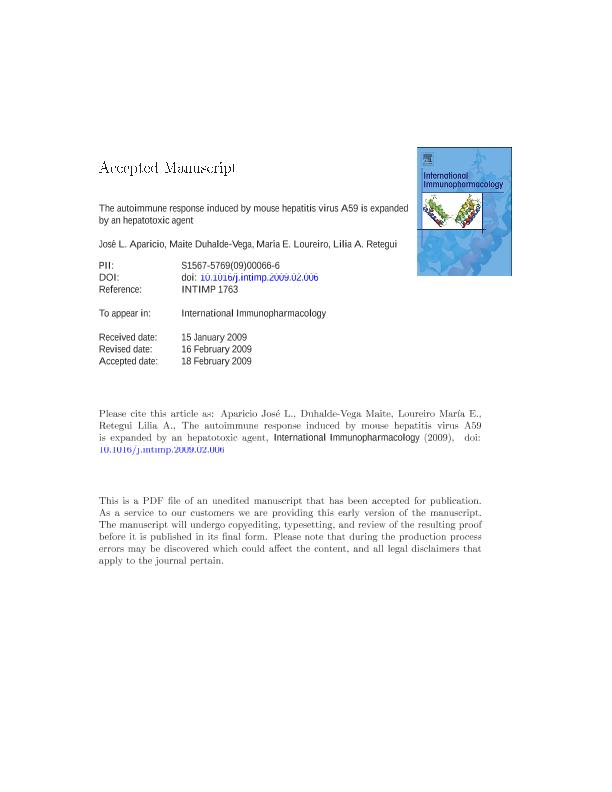Artículo
The autoimmune response induced by mouse hepatitis virus A59 is expanded by a hepatotoxic agent.
Fecha de publicación:
02/2009
Editorial:
Elsevier Science
Revista:
International Immunopharmacology
ISSN:
1567-5769
Idioma:
Inglés
Tipo de recurso:
Artículo publicado
Clasificación temática:
Resumen
Mouse hepatitis virus strain A59 (MHV-A59) triggers various pathologies in several mouse strains, including hypergammaglobulinaemia, hepatitis and thymus involution. We reported previously the presence of autoantibodies (autoAb) to liver and kidney fumarylacetoacetate hydrolase (FAH) in sera from mice infected with MHV-A59. Long-term MHV-infected mice represented a good model of non-pathogenic autoimmune response since the animals were apparently healthy in spite of the presence of autoAb. The aim of this work was to see whether a severe liver injury, which releases endogenous adjuvants, i.e. danger signals, could elicit a broader spectrum of autoAb and perhaps signs of autoimmune hepatitis. Carbon tetrachloride (CCl4) was injected into mice 30 days after MHV infection, and serum was assayed for autoAb and total IgG 20 days later. The association of MHV infection with the toxic effects of CCl4 resulted in hypergammaglobulinaemia and the production of autoAb to various liver and kidney proteins. Histological examination of liver samples showed tissue damages but without significant differences between the animals submitted to MHV+CCl4 and controls, which were either infected by MHV without CCl4, or poisoned by CCl4 in the absence of MHV infection. Those results show that liver injury after viral infection may lead to the spreading of the immune response and to an increase of serum IgG, suggesting that the procedure used herein could simulate the onset of autoimmune hepatitis.
Palabras clave:
MHV
,
AUTOIMMUNE
,
RESPONSE
,
FAH
Archivos asociados
Licencia
Identificadores
Colecciones
Articulos(ICT - MILSTEIN)
Articulos de INST.DE CS. Y TECNOLOGIA "DR. CESAR MILSTEIN"
Articulos de INST.DE CS. Y TECNOLOGIA "DR. CESAR MILSTEIN"
Articulos(IQUIFIB)
Articulos de INST.DE QUIMICA Y FISICO-QUIMICA BIOLOGICAS "PROF. ALEJANDRO C. PALADINI"
Articulos de INST.DE QUIMICA Y FISICO-QUIMICA BIOLOGICAS "PROF. ALEJANDRO C. PALADINI"
Citación
Aparicio, Jose Luis; Duhalde Vega, Maite; Loureiro, Maria Eugenia; Retegui, Lilia Alicia; The autoimmune response induced by mouse hepatitis virus A59 is expanded by a hepatotoxic agent.; Elsevier Science; International Immunopharmacology; 9; 5; 2-2009; 627-631
Compartir
Altmétricas




